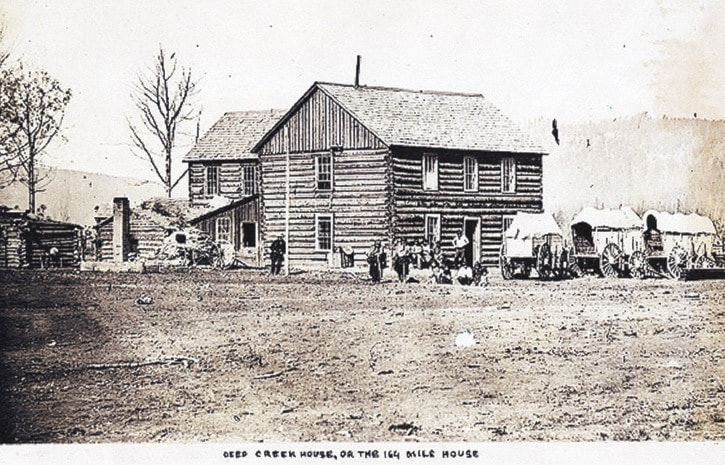Frank suggested the company overseers go into the saloon and have a drink or two while the box was being filled.
Unbeknownst to the company men, Frank had instructed his hands to fill the box 3/4 full with grain, tamp it down hard, then put a layer of loose grain over the top.
That way, the box was much heavier than if it were holding just a normal amount of loose grain.
After a few drinks, Frank and the Telegraph Co. men came back out, weighed the now full box and all agreed that was the standard weight that would be used for all future boxes.
Frank got the better part of the bargain, and the Western Union Co. paid much more than they needed to over the life of the grain contract.
By the end of 1864, the profitable era had ended for many roadhouses.
The Cariboo Wagon Road was complete to Quesnel, and stagecoaches could make it from 150 Mile House to Quesnel in less than a day, so there was no real need to stop along the way.
Frank's financial partner, G.B. Wright, was virtually bankrupt, so he sold off his interest in the Deep Creek House and farm.
Frank did not fare very well after that and soon he, too, was deep in debt.
In July, 1865, the bank foreclosed on his Deep Creek investment.
Frank decided to skip the country.
He took his best and fastest wagon, then hooked it up to his swiftest horses, piled everything he could find of value into it and he headed south as quickly as he could.
Before he left, however, Frank cut the telegraph line three miles north of Deep Creek.
The next telegraph operator up the line, Harold Yates of Soda Creek, discovered the line was dead, and set out to locate the problem.
He found the break, repaired it, and went back to Soda Creek.
There was still no contact to the south, so the following day, he went looking again.
This time, five miles to the south of Deep Creek, he found another break.
Frank Way had cut out and taken some 200 feet of wire.
There was no wire at Soda Creek to repair a break that big, so Yates had to ride to150 Mile House.
He telegraphed word of the problem south, but there was no wire at Lac La Hache or 100 Mile House, and none at 83 Mile, either.
Some wire was found at Clinton, but it took a few more days to freight it up to 150 Mile House.
In the meantime, Frank Way had made good on his escape.
He sold his team and buggy to the BC Express Company in Yale, sold off all his belongings, boarded the first steamer going downriver and was never seen in B.C. again.
The Deep Creek properties were taken over by the Bank of BC, then leased out briefly, but ultimately, they were purchased by the federal government and set aside as Indian Reserve in 1880.
The hay fields and one or two old log outbuildings are all that remain of the 164 Mile House today.
And Frank Way? The B.C. Tribune of September, 1866, reported: "Franklin Way and Billy Armstrong, both well-known in B.C., have made a lucky strike of gold in Montana. The company of five, in which Way and Armstrong are involved, took out 1,600 ounces of gold from a claim in McLennan's Gulch in a very short time."
Some men are just hard to keep down!
- This edition of Haphazard History is a continuation of a story that ran in last month's Nov. 5 Williams Lake Tribune.
